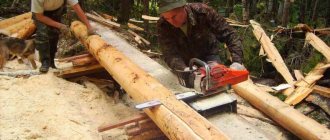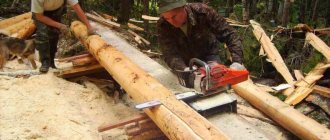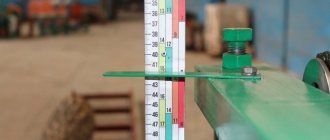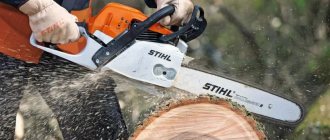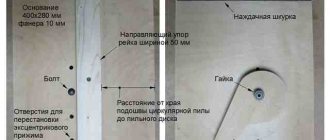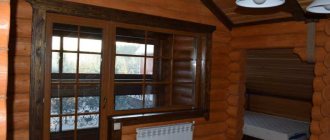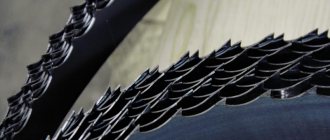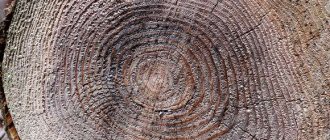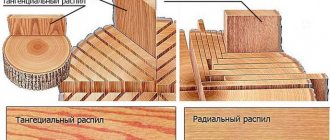Sawing logs into boards with a chainsaw
Very often there are situations when you need to produce a very small volume of boards or beams for your own needs. Of course, buying machines in this case is absolutely not an option. Having certain knowledge and skills, it is much more profitable to cut logs with your own hands, using an electric or gasoline chain saw. Despite the fact that this work is quite labor-intensive, the result is quite justified.
Most experts believe that a chainsaw
. Such equipment has high power and can operate without interruption for a long time. In addition, the operation of a chainsaw does not require electricity, so you can work far from the power supply, for example, right on the plot.
In order to cut a log into boards using a chainsaw, you will also need special tools, such as a mechanism for securing the log, a frame attachment for the chainsaw, and a guide for making the cut. The attachment frame must be attached to the chainsaw bar so that it can be used to adjust the gap between it and the chain. This will make it possible to create boards of different thicknesses. It is worth purchasing a special chain for longitudinal sawing. It has a special tooth sharpening angle. The guide ruler can be made from a metal profile of the required length or a flat, rigid board.
Before starting work, you need to remove all the bark and remaining branches from the workpieces, and also carefully inspect the log for various flaws. This way, you can choose the most suitable cutting pattern and, therefore, reduce the amount of possible waste.
If you are longitudinally sawing trunks, you need to make sure that the resulting lumber is of the same density across the entire width. Since the density of wood from the northern part of the log is much higher than from the southern part, the cut is carried out in a plane directed from east to west (or in the reverse order).
The first step is to remove the slabs from two opposite edges of the log. As a result, you will get a double-edged beam , which is then cut into boards or other lumber of equal thickness, according to the intended sawing pattern. The final product is an unedged board, from which the edges must then be removed.
Tools for sawing logs
Tools and cutting methods depend on the total volume of logs, such indicators as length and thickness. In addition, you need to take into account the quality of the future lumber. Cutting a log involves working with different tools and specialized equipment. In order to obtain a small amount of lumber at home, a manual method of processing logs using a chainsaw or traditional hand saws with teeth for longitudinal cutting is suitable.
The sawmill is perhaps the most famous type of sawmill equipment. This is a woodworking machine that contains frame saws. The sawmill produces longitudinal sawn timber, for example, edged boards or timber . Sawmills allow processing logs with a diameter of 15 to 80 cm and a length of up to 7 m.
Cutting logs into boards using circular saws (circular saws) is carried out using a circular saw. Such equipment can be single-saw (single-disc) and multi-saw (multi-disc). Devices containing one disk are suitable for working with small-sized and low-quality raw materials. Using multi-disc machines, you can cut round workpieces of large diameter.
Band sawmills are the most popular today. They come in two types: vertical and horizontal. The cutting tool in such equipment is a belt blade that is put on pulleys. Working on band saws guarantees the production of high-quality longitudinal and mixed lumber, such as boards and beams. This produces the least amount of waste.
Large industrial enterprises use wood sawing lines. They allow achieving very high surface quality and precise geometry of the final products. Such lines are characterized by the highest productivity.
In addition to all the equipment listed above, such types of highly specialized sawmill equipment as debarkers, edgers, band-dividers and other types of machines are also used.
Machines for longitudinal cutting of lumber. Video materials
Related Links. Additional Information
- Directory of woodworking machines
- Manufacturers of woodworking machines and equipment
- Manufacturers of household woodworking machines
- Manufacturers of chipping machines
- Classification of woodworking machines
- Machines for longitudinal cutting of lumber
- Sawmill frames. Classification
- Lumber. Basic concepts. Terms and Definitions
The procedure for performing preparatory work
To cut a log lengthwise
, you need to perform the following sequence of actions:
- Take two straight boards and attach one to the other at right angles. The result is a strong guide line.
- To support the manufactured ruler, you need to make stops from boards.
- Moving the trunks must be done using a tilter.
- The log should be placed on a comfortable base.
- You need to secure the frame to the chainsaw bar using nuts.
- The supports of the leading ruler must be attached to the ends of the log, checking the horizontal position with a level.
- Self-tapping screws must be used to secure all brackets and structural elements. Nails are not suitable for these purposes, since they are difficult to remove in the future without causing damage to the structural parts.
- The leading ruler needs to be attached to the supports using brackets and its height adjusted taking into account that the cut will not go along it, but approximately one centimeter higher.
- The log needs to be rotated and the second board secured so that it rests on the ground and supports the log.
Universal device for longitudinal spreading
The universal device Big Mill allows you to accurately cut logs, even those whose diameter reaches 500 millimeters. In this case, the exact thickness of the boards can be set based on a special ruler, which the operator will find on the device stand (applied directly to it). Many craftsmen create their own devices, focusing on the model of this type of universal attachment.
How to unravel a log lengthwise using a universal device? Follow this algorithm of actions.
- We take a couple of even boards, connect them, forming a T-shaped structure with an angle of 90 degrees. This design will act as a ruler, allowing the tool to move smoothly. In this case, the docks need to be twisted in such a way (taking into account the dimensions of the device for longitudinal release) that the power unit does not touch the ruler (it should be placed at a distance of 10 millimeters above).
- Creates a pair of stops, which are ready-made from two parts (L-shaped). These components will prevent the log from rotating when it is cut. For reliability, the boards are secured with metal corners.
- Rolls the log onto the stops (it is easier to roll those whose diameter is relatively small). If you need to install a large log on supports, you will need to ask someone for help.
- We connect the ends of the log and the stops using self-tapping screws (take those that are longer than the rest). You should not use nails, since the second longitudinal cut will require you to rebuild the entire structure.
- The T-shaped structure, which acts as a ruler, is attached to the stops with clamps.
- The ruler is connected to a chainsaw, on which a universal device has already been installed.
- Now we adjust the thickness of the boards that you want to get in the end. When setting this parameter, do not forget about the thickness of the saw and the gap between the T-shaped structure and the blade (10 millimeters).
- We turn the material for cutting away from ourselves by 30 (this will make cutting longitudinally much easier).
- We make a cut lengthwise.
- He removes the ruler, unscrews the clamps, and removes the stops at the ends.
- We place the T-shaped structure on the plane that we got after the first cut, secure the guide element with self-tapping screws.
- We fix the log as securely as possible in order to make an accurate second cut in the horizontal plane. It will run perpendicular to the first cut.
What will you encounter when cutting logs?
Centuries and millennia pass, new materials and technologies appear, but wood, stone and metal have been and remain the main materials used by humanity for its needs. Products made from them surround us everywhere, wherever we are, wherever we go.
Particularly noteworthy is the wood, which creates an atmosphere of coziness and comfort everywhere. Metal and stone are colder and more laconic, but wood is even warm to the touch. That is why the first two materials are used more often in the form of load-bearing structures, and wood is used in interior decoration, however, after being brought into the appropriate form.
READ How to Clean a Chainsaw Air Filter
Before you cut a log correctly, you need to inspect it. If there are no significant flaws on the outside of the tree, then processing can be done quickly and with virtually no loss of wood.
Logs must be sawed in such a way that the resulting materials have equal density. And to do this, you need to remember that the wood on the north side of the trunk has a higher density than on the south. Cutting logs lengthwise
begins with removing the slab; this part is removed from both sides of the tree to create
a beam
that will not roll.
We place the resulting timber , and the other looks up, and the cutting will begin from there. Now you can cut the remaining log into appropriate lumber or boards of equal thickness. The result is a set of unedged boards, in which the raw edge (sometimes even with tree bark) must then be cut with a handsaw. Now we can consider the work completed.
Types of working attachments
When sawing logs with a chainsaw, various attachments are used.
- Attachment for longitudinal sawing. It is used for sawing logs lengthwise, the process takes place in a horizontal position. After work, the master receives the same thickness of the product. The finished materials undergo a drying process, after which the boards are used in construction. In appearance, the device is a small frame; it is attached to the tire on each side.
- Drum debarker (debarker). With the help of such an attachment it is easy to dissolve the log; it works due to a V-belt drive. Attached to belts on both sides, special pulleys are used for this. The speed of rotation of the shaft depends on the size of the pulleys, so the performance of the attachment is easy to change. This technology forces the master to carefully monitor each stage of the process; some specialists use an assistant during this cutting. But this option requires increased security measures.
- Sawing with a lightweight nozzle. The method is not very productive, but is used quite often. The element is fastened on one side, but the workpieces are slightly uneven. Such materials are necessary for the construction of sheds or fences.
Debarkers
By design, debarkers are divided into drum and disk. The first ones are used mainly for removing bark from logs (cinders); the disk ones cut out mounting grooves, cups, recesses, etc.
The working part of the devices consists of a drum or cutter mounted in a bearing unit. Like most chainsaw attachments, debarkers are driven by a V-belt drive. a driven pulley on their axis for this purpose.
. To rip a log with a chainsaw, you need a support frame. By selecting the diameters of the pulleys and changing the engine speed using the accelerator, you can obtain the optimal rotation speed of the working tool, which provides the necessary processing parameters.
On a band sawmill - the fastest!
There are a huge number of techniques that can help you cut logs. To study them, I recommend reading my books on woodworking.
Now I’ll tell you the technique for doing it on a band sawmill. First you need to form a carriage.
To do this, you need to make cuts on two sides, or on four, but this is in special cases! The next stage is the creation of a map, which is needed so that the process of cutting the workpiece can be carefully prepared; it is at this stage that we indicate the dimensions of the board.
The determining parameter in this work is the direction of processing the log; it is especially important to pay attention to the movement of the edge that cuts the tree relative to the annual rings! It is by this criterion that various lumber with unique properties is formed. The aesthetic qualities and price of the board depend on the work performed at this stage.
There are several types of cuts that you need to know about: radial, cross, rustic and tangential.
Radial is the highest quality, because in the end you get an almost perfect board: uniform in color and texture! It does not deform under any conditions, it is clear that the price of such a product is quite high!
The tangential method is a little worse, because the boards are not so strong, but the pattern remains good, sometimes you get fancy patterns! Radical is also not bad, but it differs significantly from radial and tangential in the quality and beauty of the design! Rustic is the most unreliable, because boards of this type are heterogeneous and fragile.
It would be more expedient to talk about the simplest cutting method. It's called circular. They remove the first slab, then turn the log one hundred and eighty degrees, place it on the edge, then you have to turn it many, many times! And so you will definitely succeed!
Sawing map
The sawing map is a calculation of the optimal amount of finished lumber from one log. You can calculate it yourself for each specific log diameter, or you can use a computer program that greatly facilitates the calculation, and the price of which is quite affordable.
Material yield after cutting wood
Or the source could be a regular sawmill reference book. The result is a table that is used as a basis. The sawmill attachment should always be oriented to its data in order to obtain more lumber of any type of wood.
Chainsaw cutting technology
Before you cut a log into boards at home, you need to cut it correctly in order to get the maximum number of high-quality boards with a minimum amount of waste. Rational use of raw materials is achieved by using special cutting schemes. Markings are applied to the tree that correspond to the intended purpose and the type of lumber planned.
Before starting work, it is necessary to carefully secure the workpiece in order to achieve a high quality surface of the boards. The cutting of logs is most often carried out horizontally. The advantage of horizontal cutting is that less effort is required to hold the chain saw suspended. You can cut the workpiece along the chainsaw using devices for longitudinal sawing - a wooden stop - a device made by yourself.
When using a rip saw attachment, you must carefully secure it to the body of the chainsaw. Before starting work, you need to take care of creating a base surface, parallel to which the chainsaw will be cut.
It is necessary to insert wedges into the longitudinal cut to avoid pinching the chainsaw blade with the sawed edge of the board. The saw should move smoothly and should not be pressed with force. It is better to saw a log with two people, since additional hands are needed to move and secure the workpiece in order to insert the wedges into the cut.
Knowing all these subtleties and features, it’s easy to cut the timber
or log on boards.
How to cut a log lengthwise with a chainsaw
The video shows a log being dismantled lengthwise with a chainsaw. Main channel.
READ Can you cut steel with a hacksaw?
To saw
log
along
, you need to perform the following steps:
- Make a leading line. To do this, you need to fasten two straight long boards at an angle of 90 degrees.
- Place the log on the stops, thus fixing its position.
- Attach the nozzle.
- Using self-tapping screws, attach the supports to the ends of the log on both sides. Check horizontality with a level.
- Attach the leading ruler to the supports with self-tapping screws.
- Install another support board horizontally. which should rest against the ground and slightly lift the log.
- Using a chainsaw with a horizontal cutting attachment, cut off the first piece of log.
- Move the guide ruler and fix it.
- Make a second cut of the log perpendicular to the first.
- There is no need to use the leading ruler any further. The resulting board will serve as a guide.
- Determine the thickness of the cut using the frame.
- Make the next cut perpendicular to the second. The result should be a piece of wood, the underside of which is covered with bark.
- Make a fourth cut to separate the remaining part of the wood that contains the bark. You will get an almost perfectly even block of wood.
- Next, cut the block to the middle.
- Turn it over to the opposite side and continue cutting until the end.
If the thickness of the boards does not matter, cutting off the edges with bark is not necessary. In this case, you can use an edger and cut into boards from the very beginning.
Cutting a log in half lengthwise
This video shows how to mark a log for its subsequent dissolution along, and, directly.
First of all, it will be necessary to make guides: fold two neat boards and fasten them in the shape of a half-Tee. Then we use various pieces to create stops for the half-Tee guide! It seems that everything is clear and simple so far!
We lay the log on a flat platform, which we will prepare in advance, then we roll the object from place to place; this can be done quickly and conveniently using a tilter. We secure the frame to the tire with nuts very tightly, so that it does not fly off even in the event of an earthquake. We fasten the supports, they are needed in order to press the ruler to the ends of the logs!
The ruler itself is needed for the worker to see the width of the board. We will secure all the fasteners with self-tapping screws, so that nothing will fly off on you at the most crucial moment! Then the most interesting part of the work begins, because all the preparations, for the most part, have already been completed.
All that remains is to check the cutting line, it should be 10 millimeters above the ruler! So, holding our breath, we start the saw and make the first cut. Then you will have to free the log from any pieces of iron - stops and rearrange the structure to the next cut line, but this must be done as carefully and accurately as possible so that the first cut is perpendicular to the first cut!
Then we turn the log again and fix it with boards to the stops that are on the ground! We start the unit and saw...saw. we saw, enjoying our work.
Yes, cutting at home is hard work, but you can do everything efficiently and on your own! Just remember, for this task you need more than one such device, it is better to make a right angle on the trunk, and then you will be able to prepare boards of any width.
A chainsaw is a multifunctional tool!
In order to perform this type of work using a chainsaw, you don’t need to solve many actions at all! But this is not for beginners. For those who are starting to do this type of work! And this has to be done virtually from scratch; the ideal thing would be to purchase a machine. You can read about how to do it in my article here.
It will come in handy. In order to fix the logs, you also need a cutting guide and attachment frames - all this is used for the same purpose! No, you, of course, can try to make all these products independently, with your own hands, but remember that the equipment will be under heavy loads, so at the most important moment some problem may occur with homemade devices that may threaten your life and health.
If the thickness of the boards does not matter, cutting off the edges with bark is not necessary. How to cut a log straight along
chainsaw. In this case, you can use the edger and create the cut into the boards from the very beginning.
Longitudinal cutting of a log with a STIHL MS 180 chainsaw
Making cross cuts
Cross-cutting is used to cut logs into firewood, as well as to create cross-cut wooden disks for building garden benches, decorating garden paths, etc.
Cutting a log crosswise is done as follows:
- Place the log horizontally on wooden supports 0.5 m high.
- If necessary, you can clear it of bark.
- Using an ax or saw, make marking cuts at equal distances from each other.
- According to the marks, cut the log.
Special attachments and chains are not needed for this work. A regular chain will do.
Sawing logs lengthwise
To get an even cut, you need to install a guide. It can serve as a mini sawmill of an industrial standard. But such devices are not cheap and not everyone can afford them. Therefore, logs are usually fixed with homemade holders made of boards with the same guide.
Sawing of logs into boards is carried out with a chain for longitudinal cutting. If you don’t have one, an ordinary chain will do, sharpened at an angle of 10 degrees. Only in the process of work will you have to sharpen it from time to time. An attachment is installed on the chainsaw - a guide frame for an even cut.
Chainsaw sawmill
This type of design is the easiest to manufacture, but it will also require special skills, tools and experience working with them.
This type involves installing the carriage on guides, but is not mandatory. You can use a flat wooden plank as guides, along which the carriage structure will slide easily. It allows you to remove the first layer evenly. The cutting plane on the log is used as subsequent guides.
Attention! The absence of a frame and carriage adds a number of difficulties. The craftsman may have problems holding the log in one position. It is impossible to start work without proper fixation, as this can lead to injury.
You cannot start work without proper fixation, as this can lead to injury.
The step-by-step process for making a carriage for a chainsaw will look like this:
- Let's make the base. To do this, we weld together a pipe measuring 25x25 mm.
- Perpendicular tubes, the size of which is 30x30 mm, are welded to the base on opposite sides. They are necessary for attaching the moving part that holds the saw and sets the thickness of the planks to be cut.
- Nuts are welded into the side parts of the guides. With their help, it will be possible to fix the moving parts at the desired height with bolts.
- We make the moving part. It consists of two pipes with a T-shaped end. The end of the pipes is made in the form of a vice, clamped with bolts and nuts. These clamps will hold the chainsaw blade. Pipe size – 25x25 mm.
- To prevent the saw chain from rubbing against metal parts, two metal plates of the required sizes are welded onto the internal parts of the vice. They completely depend on the thickness and width of the chainsaw blade.
- We assemble the carriage into a single structure, select the desired height and install the saw. The sawmill is ready for use.
The video below fully describes the carriage manufacturing process. In addition, the author of this device notes the main difficulties and some inaccuracies that he made during the assembly of the sawmill. This will allow you to avoid such mistakes and make the device for sawing logs more practical.
Bottom line! This carriage design is suitable for personal use and one-time sawing of wood. It is not suitable for commercial purposes.
How to Cut a Log Along a Chainsaw
We cut logs into boards with our own hands
Cutting a log into planks with a Stihl ms180 chainsaw
Greetings, readers of Andrey Noak's blog. How to cut a log into boards at home with your own hands? - this is a question that torments many people with “golden hands” and fascinating thoughts! It was not in vain that I turned to this topic now, because I want to offer several interesting options. I think I can tell you about them in small details so that you can understand as much as possible how the cutting is done.
READ Cut the Rail with a Hacksaw for Metal
Sawing logs lengthwise
To get an even cut, you need to install a guide. The problem is how to cut a log into boards with a chainsaw, in addition to sawing logs for firewood. Sawing logs into boards with a chainsaw - do-it-yourself installation instructions, cutting features, how to cut them at home, price, photo. It can serve as a mini sawmill of an industrial standard. Some people have the opportunity to take a certain area in the forest for logging in order to split the trunks, but how to cut a log into planks with a chainsaw if you have never done it. Sawing logs into boards with a chainsaw as it is used to cut the log lengthwise. How to cut
log lengthwise with a chainsaw - do-it-yourself installation instructions, features of devices for longitudinal sawing, cutting into boards, price, photo. But such devices are not cheap and not everyone can afford them. Therefore, logs are usually fixed with homemade holders made of boards with the same guide.
Sawing of logs into boards is carried out with a chain for longitudinal cutting. If you don’t have one, an ordinary chain will do, sharpened at an angle of 10 degrees. Only in the process of work will you have to sharpen it from time to time. An attachment is installed on the chainsaw - a guide frame for an even cut.
Devices for longitudinal sawing of logs (mini sawmills)
Device for vertical cutting of logs
. The simplest is the device for vertical sawing of logs, shown below.
It consists of an adapter (1), attached to the tire at its base, and a guide (2), which determines the straightness of the adapter's movement. The guide is installed on the board (3), which in turn is attached to the log being cut.
The main purpose of this device for a chainsaw is to ensure the straight movement of the bar. With its help, you can not only dissolve a log into two or four parts (quarters) or cut a beam out of it, but also saw it into boards or beams. However, in the latter case, you will have to rearrange the board with the guide each time, and it will not be possible to achieve great accuracy when sawing. The unfixed end of the tire may move to the side, as a result of which constancy of the parameters and complete parallelism of the sides of the beams or boards are unlikely to be achieved.
Device for horizontal cutting
.
Using the device shown in the photo below, logs are cut in a horizontal plane. Compared to a device for vertical cutting, it has increased functionality and accuracy, allowing you to cut boards or beams of the same thickness.
A device attached to the tire in two places. beginning and end. has a frame structure that ensures the rigidity of the device. The mounting location (1) can move along the tire. This allows you to set the required cutting width (according to the diameter of the log ). within the length of the tire. The guides (2) can be installed at any distance from the tire, thereby ensuring the required thickness of the cut beams or boards. The first horizontal cut is carried out using a guide frame (3) mounted on the log and serving as a base surface for the guides (2). For subsequent cuts, the flat surface (4) obtained in the previous pass is used as the base surface. During operation, to avoid pinching the saw, wedges are inserted into the cut to prevent the cut from narrowing.
If it is necessary to cut logs whose diameter exceeds the length of a standard bar, a more complex device is used, which uses a long bar. In this case, the saw’s native lubrication system does not provide high-quality lubrication of the entire chain, so it becomes necessary to install an additional system consisting of a tank and a hose that supplies lubricant to the end of the bar. To ensure oil supply by gravity, the tank is placed on a rack above the tire.
Features of sawing using a homemade tool
Saw
You can easily place a log on boards using a self-made tool. It's easy to make. To do this you need to do the following:
- As a support, you need to use a frame from a school desk or a pipe with a cross-section in the form of a square, its optimal size is 20x20, more is allowed.
- It is necessary to build two clamps, mount a cross member with two holes for coupling bolts at one end, and make a protrusion for the tire in the middle.
- To cut logs longitudinally into boards, you need to make a support frame; its width should be seven to eight centimeters less than the length.
- Then two parts ten centimeters long are welded to both sides, holes are made for the bolts, and a handle is attached in the middle for ease of operation.
- Then you need to insert the clamps into the grooves, install the tire, and secure everything carefully.
Working with a homemade tool is not difficult; for this you will need goats, they will serve as a support. In addition, you need to prepare a metal strip or board to use as a guide. A log is placed underneath and the required height for work is set.
Overview of some options
We will tell you about the two most popular designs that provide the best quality when working, and you yourself will determine which is more convenient and preferable in your case.
Homemade option
First, let's look at how to make a device for sawing logs with a chainsaw with your own hands.
The instructions for carrying out the work are as follows:
- It is best to use a frame from an old school desk or a square pipe with a side of 20x20 or slightly larger.
- First of all, two clamps are made, these are elements 50-60 cm long, at one end of which a crossbar with two holes for tightening bolts and a small protrusion in the middle for clamping the tire is welded, an element of the same configuration is attached on top, the photo below shows ready-made elements, as you can see, everything is quite simple, and if you have a welding machine on hand, you can make them very quickly.
The clamps should be sized so that the width of the bolts is slightly greater than the height of the bar
- To longitudinally saw a log with a chainsaw, you need a support frame, the width of which should be 7-8 centimeters less than the length, two elements 10 cm long are welded perpendicular to two of the sides, they should be a little larger so that the clamps fit into them, you need install two fixing bolts; for this, a hole is drilled and nuts are welded in order to screw the fasteners into them; a handle is welded in the middle for ease of movement.
- The system is assembled in the following way: first, the clamps are inserted into the grooves, after which the chainsaw bar is inserted and carefully fixed. The distance is selected depending on the thickness at which sawing needs to be done. To understand how this is done, look at the photo, which shows the assembled structure, the price of the issue is several metal elements and rental of welding for an hour.
This is what the device looks like after assembly
Now we’ll tell you how to cut a log into boards with a chainsaw using this design:
- You will need two sawhorses to serve as supports, they should be of such a height as to ensure ease of work.
- A reliable metal strip or durable board is best suited as a guide. You can make this element from a corner or other metal products.
- A log is placed below, which needs to be set to the desired height, after which work can begin. After the first pass, the log is raised to the desired height and the process is repeated.
The work is quite simple, the main thing is to set everything accurately and fix it securely
Ready solution
The Big Mill Timberjig option is very popular; it is a special kit for equipping a mini sawmill. Sawing logs into boards with a chainsaw using this device is simple and effective.
By purchasing this option, you get everything you need; we’ll tell you how to organize the cutting of logs:
The design is very well thought out and is simple and reliable.
- First you need to connect two strong and even boards together, as a result you should get a T-shaped structure. This will be a stubborn ruler.
- Next, make two L-shaped stops; the delivery set includes corners that are designed specifically for these purposes.
- Roll up the log and place it on comfortable and reliable bars. Attach supports to its ends with self-tapping screws; you should not use nails, since they are much more difficult to remove later.
- Next, a ruler is attached to the installed wooden supports; this is done using clamps, which are also included in the kit, remember that the cut line does not go along the edge of the guide, but 10 millimeters higher.
- Before cutting a log into boards with a chainsaw, we recommend raising one side by about 30 degrees, this will make it much more convenient to work. Fix this position with the help of two supports; if something is not clear to you in the description, look at the photo, everything is shown clearly on it, in addition, the kit always comes with instructions with detailed diagrams.
How to cut a log into planks with a chainsaw? This device allows you to do this easily and quickly
Types of working attachments
When sawing logs with a chainsaw, various attachments are used.
- Attachment for longitudinal sawing. It is used for sawing logs lengthwise, the process takes place in a horizontal position. After work, the master receives the same thickness of the product. The finished materials undergo a drying process, after which the boards are used in construction. In appearance, the device is a small frame; it is attached to the tire on each side.
- Drum debarker (debarker). With the help of such an attachment it is easy to dissolve the log; it works due to a V-belt drive. Attached to belts on both sides, special pulleys are used for this. The speed of rotation of the shaft depends on the size of the pulleys, so the performance of the attachment is easy to change. This technology forces the master to carefully monitor each stage of the process; some specialists use an assistant during this cutting. But this option requires increased security measures.
- Sawing with a lightweight nozzle. The method is not very productive, but is used quite often. The element is fastened on one side, but the workpieces are slightly uneven. Such materials are necessary for the construction of sheds or fences.
DIY chainsaw carriage. Blueprints
Since the price of professionally produced equipment (similar to that described in the previous section) ranges from 2500 to 3000 US dollars, it is not difficult to come to the conclusion that you can make your own carriage design for longitudinal sawing of timber.
Depending on the size of the chainsaws used, the dimensions of the carriage assembly, as well as its appearance, are shown in the figure.
The manufacture and assembly of a carriage for a chainsaw is carried out in the following sequence. First, the drive motor is prepared for installation. To do this, remove the drive pulley and install the engagement clutch, resulting in a finished cutting head. A support bracket must be made for the motor mounting plate. By changing the diameter of the pulley, you can control the cutting speed of timber - up to 2.5 times faster than allowed by the base engine speed. To reduce the temperature and eliminate the possibility of engine jamming, its output shaft is ground so that the chain drive sprocket, without taking into account the dimensions of the central bearing, fits tightly to the bracket.
The presence of a belt drive on the shaft that drives the chain protects the engine from vibration and shock generated by the chain. All that remains is to adjust the gearing to get the correct chain speed. Then it is necessary to install bearings on the drive shaft for more intense operating conditions, with increased load-bearing capacity.
Most home renovation and construction work requires the availability of the necessary materials. Buying boards or timber of the right size is not a problem, but sometimes you need lumber of a certain size. Planks of one or another type of wood, non-standard thickness or width are often required. Finally, there are simply several logs from which to cut boards. It is possible to solve such problems; you only need a DIY chainsaw carriage.
This simple device allows you to make a carriage, timber or boards of the required thickness from logs of any type. This device is especially valuable because it makes it possible to process non-standard logs - short, uneven or strongly curved. Let's take a closer look at this issue.
The advantage of a chainsaw as a tool for sawing logs
You can saw a log using a sawmill, gas or electric saw and additional accessories. When choosing one of these tools, you should consider the amount of work ahead. The cost of the cheapest stationary sawmill along with all components is 150 thousand rubles. Chainsaw
costs much less. It is more convenient than an electric saw for the following reasons:
- Electricity is not required to operate the tool - this makes it possible to use a chainsaw on plots.
- It is more powerful compared to an electric saw.
- It starts smoothly and allows you to conveniently adjust the speed, which reduces the likelihood of a chain break.
- The inertial brake operates faster than that of an electric saw.
- Long working time without interruption – up to one hour.
- Can be used in conditions of high humidity.
Preparing for work
Before starting work, it is recommended to sort the trees depending on their purpose. It is necessary to clean them from dirt, remove knots and nails. Sorting is done according to the following criteria:
- trunk diameter;
- curvature;
- number of knots, various defects;
- core diameter.
Immediately before cutting you need to:
- Check the quality of fastenings and connections of parts.
- Check for grounding.
- Lubricate surfaces subject to friction.
- Check that the band saw is installed correctly.
- Check the belt movement at idle and reverse.
- If necessary, change the saw boom by moving the roller on the left side by 5-10 cm.
The log, prepared in this way for sawing, is placed on the frame and securely secured with clamps. You need to make sure that it moves freely between the guides.
The procedure for performing preparatory work
To saw
log lengthwise, you need to perform the following sequence of actions:
- Take two straight boards and attach one to the other at right angles. The result is a strong guide line.
- To support the manufactured ruler, you need to make stops from boards.
- Moving the trunks must be done using a tilter.
- The log should be placed on a comfortable base.
- You need to secure the frame to the chainsaw bar using nuts.
- The supports of the leading ruler must be attached to the ends of the log, checking the horizontal position with a level.
- Self-tapping screws must be used to secure all brackets and structural elements. Nails are not suitable for these purposes, since they are difficult to remove in the future without causing damage to the structural parts.
- The leading ruler needs to be attached to the supports using brackets and its height adjusted taking into account that the cut will not go along it, but approximately one centimeter higher.
- The log needs to be rotated and the second board secured so that it rests on the ground and supports the log.
Sources:
https://90zavod.ru/raznoe/kak-raspilit-vdol-brevno-benzopiloj-instrukciya-kak-raspilit-brevno-vdol-benzopiloj.html https://superarch.ru/materialy/kak-raspilit-brevno-vdol -benzopiloj
